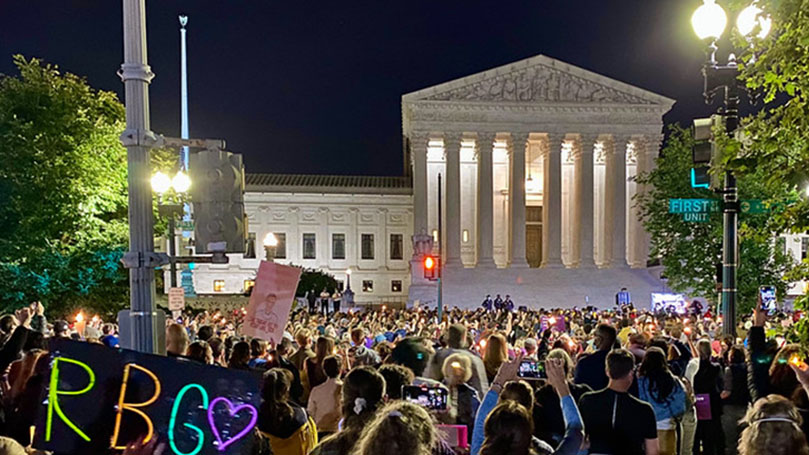
Justice Ruth Bader Ginsburg’s death is a loss for democracy and progress for years to come. The Supreme Court now has five conservative justices to only three liberals. It appears inevitable that President Trump will fill the vacancy with Amy Coney Barrett, so the score changes to six to three for whoever wins in November. That will nullify Chief Justice John Roberts’s occasional swing votes. This will represent a hard shift to the right.
The hypocrisy of McConnell and the Trump Republican Party is stark. In 2016, Justice Antonin Scalia died in February. McConnell claimed it would be unfair if the current administration and Senate considered a nomination because the upcoming election was too close. Voters deserved their voice. Republicans spoke of the principle of the matter. So President Obama’s selection of Judge Merrick Garland wasn’t considered.
The GOP claimed it was following the “Biden rule.” One problem: there has never been a Biden rule. Then-Senator Biden in late June 1992 spoke of divisive Supreme Court nominations and urged a pause until after elections, should a vacancy occur. There was no vacancy, no nominee, and no vote on a new rule. The Biden rule is fiction.
The day Ginsburg died, McConnell said what now counted were the 2018 senatorial elections. Voters expanded the Senate’s Republican majority because it supported Trump’s agenda, “particularly his outstanding appointments to the federal judiciary.” This is deemed more important than this year’s presidential election.
Republicans also claim this time is different because when the same party controls the White House and Senate, it fills Supreme Court vacancies in election years. This qualifier wasn’t mentioned four years ago. So much for their “principles of democracy” argument.
The new McConnell rules are now in session.
1. Wait for elections if conservative justices (Scalia) die and Democratic presidents (Obama) choose replacements, especially when Republicans (Trump) might win the presidency.
Even if the election is 33 weeks* away, we must wait.
2. Don’t wait for elections if liberal justices (Ginsburg) die and Republican presidents (Trump) choose replacements, especially when Democrats (Biden) might win the presidency.
Even if the election is 46 days* away, we must not wait.
* Time deadlines may change at the whim of the Republican Party.
Only two Republican Senators (Susan Collins of Maine and Lisa Murkowski of Alaska) have said this year’s elections are too close to consider a nominee. So there is no stopping Trump and McConnell. The only issue is the timing. Confirming the nominee before November 3 is needed so unfavorable election results won’t interfere. But this is an admission that Trump might be a one-termer. That strategy is in place, as opposed to waiting for the elections in order to lure evangelical and Catholic anti-abortion voters in full force.
Conservatives have the only 50-plus-year-old members on the bench, and liberal Stephen Breyer is already 82. Failure to elect Vice President Joseph Biden and Senator Kamala Harris or a Democratic majority in the Senate puts a fourth Trump nominee in reach, which would give conservatives a seven to two majority.
Critics who say Biden-Harris are too “neoliberal” must remember that it was then–First Lady Hilary Clinton who convinced President Bill Clinton to name Ginsburg. The differences between the Supreme Court choices of the two parties are obvious and easy to see, for decisions are either Yes or No: a case either wins the majority or not. There are no ideological nuances involved (not withstanding various majority or minority opinions).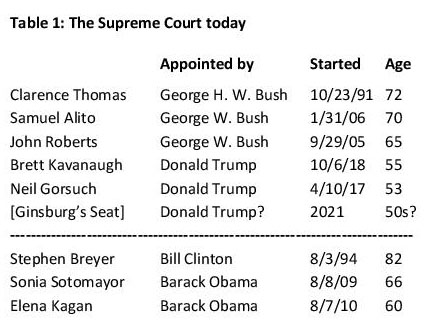
The Federalist Society
Justices Brett Kavanaugh and Neil Gorsuch and 90% of Trump’s other 212 federal judicial appointments are members of the Federalist Society. It stresses the legal principles of “separation of powers; federalism; limited, constitutional government; and the rule of law in protecting individual freedom and traditional values.” These fundamentals have been hostile to workers’ and equality movements but friendly to class exploitation, slavery, sharecropping, union busting, and violations of civil and social rights for every “class” (in the Court’s lexicon) suffering from discrimination.
Some of the nation’s most extreme right-wing capitalists fund the group: the Richard Mellon Scaife Foundation, Charles G. and his now-deceased brother David H. Koch, Chevron, and the Mercer Family. It was the central cause of the John M. Olin Foundation. Another money spigot is Google.
The organization brags it “has redefined the terms of legal debate” through its experts’ interactions with “the legal profession, the judiciary, law students, academics, and the architects of public policy.” With possibly five members (Trump’s two plus Roberts, Alito, and Thomas) residing in the Supreme Court, the claim is true. When looking at the circuit courts (the U.S. Courts of Appeals), it’s so true it hurts.
Confirmation battles in the Senate
Unending filibusters—long speeches used to delay taking a vote—emerged in the U.S. Senate in the late 1830s. Not until 1917 did the Senate agree on a rule to end them: filibusters could be terminated if two-thirds of all voting senators desired. This was lowered to three-fifths in 1975, which means that 60 of the 100 senators must vote to end discussion and take a vote on the issue at hand. This included confirming federal judges.
During Obama’s term, after the Democratic Party Senate majority slipped to 59 to 41, the GOP repeatedly filibustered the president’s nominees to U.S. District but especially the Circuit Courts. Vacancies were piling up. Finally, in November 2013, Democrats changed the rules: merely 51 votes, instead of 60, could end debate for nominations to these courts, though not for the Supreme Court.
Figure 1: The federal court system

Note: specialized federal courts are omitted.
The reform helped fill some vacancies, but Republicans regained control in the 2014 midterms and perfected stonewalling. Never before had the Senate refused to confirm so many nominees.
Several years later, Republicans applied the rule change to Supreme Court nominees, too. Only 54 of 99 Senators voted to confirm Gorsuch, and only 50 of 98 did so for Kavanaugh. These were the thinnest confirmations since Clarence Thomas in 1991 (52 to 48). Prior, only three other justices received so few confirmation votes.
Federal judges are employed for life. Incredibly, one judge named by Pres. Lyndon Johnson (who left office in January 1969) and six by Richard Nixon (who resigned in August 1974) are still around! (Johnson’s and three of Nixon’s are inactive, meaning they don’t hear cases, but they can serve on court committees.)
Federal circuit and district courts
The Supreme Court is asked to review nearly 1,000 cases but accepts only around 1% of the requests. The circuit courts have much more influence because nearly all their rulings remain in effect without successful overturning by the Supreme Court.
These appellate courts hear appeals from district-level court rulings. Most of the vacancies created by Republican refusal to deal with Obama’s nominees have been filled by Trump. Of his 53 judges, nearly all are Federalist Society members. Two-thirds of them are white men, making these courts less diverse — except with regard to age, since they are younger than were most of the appointees by Obama and George W. Bush. Nearly all were politically active in the past, and some have unfavorable ratings from the American Bar Association.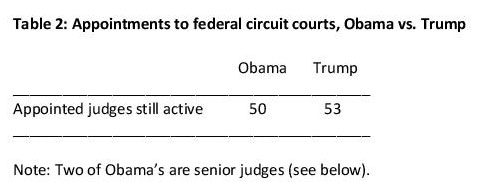
Source: Wikipedia
Senator Patrick Leahy (D-Vt.), chaired the Judiciary Committee before the Democrats lost control of the Senate in the 2014 elections. He reinstituted a practice that allows U.S. senators to nix nominees from their home states. Republicans naturally abused the habit. For example, Senator Ron Johnson of Wisconsin kept a seat open in the Seventh Circuit for eight years until Trump filled it.
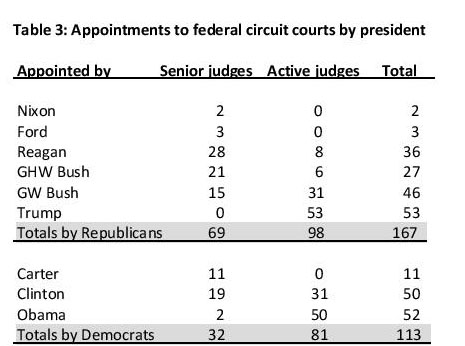
Source: Wikipedia
As Table 3 shows, Republicans have named 55% percent of all current active judges and 68% of all current senior judges. (Senior judges vacate their seats, which can be filled by presidents, but they continue receiving salary. Some work full-time, while most take a reduced load.) Combining both groups, the GOP has named 60%.
As Justice Sonia Sotomayor said, “The court of appeals is where policy is made.” However, the district courts are not immaterial. Conservatives don’t dominate this level to the extent they do with circuit courts, but a Trump reelection can change that.
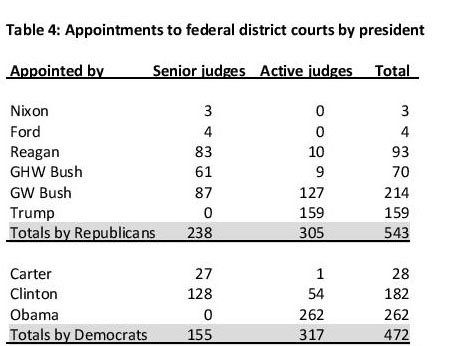
Source: Wikipedia
Clinton gave us Ginsburg and Breyer. Obama gave us Sonia Sotomayor and Elena Kagan. Under George H. W. Bush we received Clarence Thomas to replace the honorable Thurgood Marshall. (Though it is also true that Father Bush named David Souter, who replaced William Brennan and was replaced by Sonia Sotomayor.) Bush’s son, George W., bequeathed to us Justices Roberts and Alito. Trump’s Electoral College victory left us with Gorsuch, Kavanaugh (who was publicly accused of sexual assault while drunk), and now a polar opposite replacement for the legendary Ginsburg.
Utah’s Senator Mitt Romney falsely claims that liberal office holders expect a liberal Supreme Court, but that is also Republican fantasy. Conservatives have dominated the Supreme Court for nearly its entire history.
Activists and voters must wake up to this reality. The working class, unions, and racial and national groups facing systemic discrimination are greatly injured by circuit and Supreme Court rulings. So are women, LGBTQ communities, and the elderly. On the federal level, presidential and senatorial elections greatly matter, and litmus tests to find “properly” progressive candidates serve to help the extreme right.
Will we again fail to elect “not good enough” Democrats at the top of the ticket and for senators, in a two-party system, and perhaps have another four years of Federalist Society members sworn in? If both parties and candidates are so similar that it doesn’t matter, how does one explain the difference in court justices and judges?
President Trump and Senate Republicans are doing special damage to the federal court system. His selections have been worse than the bad choices of earlier Republicans. Another four years will extend the life of hostile rulings even further into the future. Electing the imperfect Joe Biden andKamala Harris this November 3 can help stop this extreme right takeover of federal courts.
Image: Ted Eytan (CC BY-SA 2.0).


 Join Now
Join Now